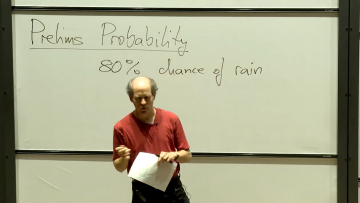The first of six 'Probability' lectures we are showing, taken from the first year undergraduate course, is now available to watch.
The First Year Probability lectures are for students of Mathematics, Computer Science and joint degree courses between Mathematics and Statistics and Mathematics and Philosophy. First year lectures are supported by lecture notes and complemented by one problem sheet for every two lectures, which students are asked to solve in preparation for discussion in pairs with their tutors in tutorials.
Holography is one of a set of powerful tools which theoretical physicists use to understand the fundamental aspects of nature. The holographic principle states that the entire information content of a theory of quantum gravity in some volume is equivalent (or dual) to a theory living at the boundary of the volume without gravity. The boundary degrees of freedom encode all the bulk degrees of freedom and their dynamics and vice versa.
12:00
Well-posedness of nonlocal aggregation-diffusion equations and systems with irregular kernels
Abstract
Aggregation-diffusion equations and systems have garnered much attention in the last few decades. More recently, models featuring nonlocal interactions through spatial convolution have been applied to several areas, including the physical, chemical, and biological sciences. Typically, one can establish the well-posedness of such models via regularity assumptions on the kernels themselves; however, more effort is required for many scenarios of interest as the nonlocal kernel is often discontinuous.
In this talk, I will present recent progress in establishing a robust well-posedness theory for a class of nonlocal aggregation-diffusion models with minimal regularity requirements on the interaction kernel in any spatial dimension on either the whole space or the torus. Starting with the scalar equation, we first establish the existence of a global weak solution in a small mass regime for merely bounded kernels. Under some additional hypotheses, we show the existence of a global weak solution for any initial mass. In typical cases of interest, these solutions are unique and classical. I will then discuss the generalisation to the $n$-species system for the regimes of small mass and arbitrary mass. We will conclude with some consequences of these theorems for several models typically found in ecological applications.
This is joint work with Dr. Jakub Skrzeczkowski and Prof. Jose Carrillo.
12:00
Pressure jump in the Cahn-Hilliard equation
Abstract
We model a tumor as an incompressible flow considering two antagonistic effects: repulsion of cells when the tumor grows (they push each other when they divide) and cell-cell adhesion which creates surface tension. To take into account these two effects, we use a 4th-order parabolic equation: the Cahn-Hilliard equation. The combination of these two effects creates a discontinuity at the boundary of the tumor that we call the pressure jump. To compute this pressure jump, we include an external force and consider stationary radial solutions of the Cahn-Hilliard equation. We also characterize completely the stationary solutions in the incompressible case, prove the incompressible limit and prove convergence of the parabolic problems to stationary states.
12:00
A new understanding of the grazing limit
Abstract
The grazing limit of the Boltzmann equation to Landau equation is well-known and has been justified by using cutoff near the grazing angle with some suitable scaling. In this talk, we will present a new approach by applying a natural scaling on the Boltzmann equation. The proof is based on an improved well-posedness theory for the Boltzmann equation without angular cutoff in the regime with an optimal range of parameters so that the grazing limit can be justified directly that includes the Coulomb potential. With this new understanding, the scaled Boltzmann operator in fact can be decomposed into two parts. The first one converges to the Landau operator when the parameter of deviation angle tends to its singular value and the second one vanishes in the limit. Hence, the scaling and limiting process exactly capture the grazing collisions. The talk is based on a recent joint work with Yu-Long Zhou.
12:00
Non-regular spacetime geometry, curvature and analysis
Abstract
I present an approach to Lorentzian geometry and General Relativity that does neither rely on smoothness nor
on manifolds, thereby leaving the framework of classical differential geometry. This opens up the possibility to study
curvature (bounds) for spacetimes of low regularity or even more general spaces. An analogous shift in perspective
proved extremely fruitful in the Riemannian case (Alexandrov- and CAT(k)-spaces). After introducing the basics of our
approach, we report on recent progress in developing a Sobolev calculus for time functions on such non-smooth
Lorentzian spaces. This seminar talk can also be viewed as a primer and advertisement for my mini course in
May: Current topics in Lorentzian geometric analysis: Non-regular spacetimes



